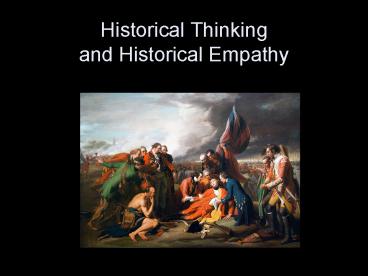Historical Thinking and Historical Empathy - PowerPoint PPT Presentation
1 / 15
Title:
Historical Thinking and Historical Empathy
Description:
Historical Thinking and Historical Empathy Historical Thinking is. . . Not Recall Mere reenactment Mere process or method with no facts Instead it is Question-driven ... – PowerPoint PPT presentation
Number of Views:627
Avg rating:3.0/5.0
Title: Historical Thinking and Historical Empathy
1
Historical Thinkingand Historical Empathy
2
Historical Thinking is. . .
- Not
- Recall
- Mere reenactment
- Mere process or method with no facts
- Instead it is
- Question-driven
- Analytical
- Applied knowledge
- Evidence-based interpretation
3
To quote Bruce Lesh
- History is about the debate between competing
interpretations of events, individuals, and ideas
of the past based on the utilization of
historical evidence. - Bruce Lesh, Why Wont You Just Tell Us the
Answer? Teaching Historical Thinking Grades 7-12
(Portland, ME Stenhouse Publishers, 2011), 4.
4
Essential Skills
- Posing historical questions/framing historical
problems - Establishing significance
- Correlation from disparate sources
- Sourcing
- Contextualization
- Citingsupporting claims with evidence
- Critical engagement with the other side
- Recognizing limitations to knowledge
5
Historical Empathy is NOT
- Putting students in positions where they will
have the same beliefs or experience the same
emotions experienced by people living in the
past. - An exercise in imagination over
- Being (imagine you are an Apache warrior)
- Identification (identify with Adolf Hitler)
- Sympathy (sympathize with victims of slavery)
- Being the person in the past
6
Historical Empathy IS
- Understanding the past as making sense in light
of the way people saw things. - Asking why did an individual or group of people,
given a set of circumstances, act in a certain
way? - Judging past actors in their own historically
situated context and on its terms. - Cultivated as an observer of the past, not as an
actor in the past. - An exercise in a specific type of
imaginationHistorical imagination.
7
Historical Imagination is. . .
- Not
- Fictional or fantasymaking up information
- Detached from evidence or context
- Imagining myself in the past as I think today
- Instead, it is
- Rooted in students understanding of context and
their analysis of evidence - An intellectual leap between information in
historical sources and gaps within the evidence
trail.
8
Asking Questions and Framing Problems
- An unnatural act
- Moving beyond the facts to significance
- Six honest serving men
- Who
- What
- When
- Where
- Why
- How
9
Establishing Significance
- What is the historians purpose in investigating
a given event? - Was the event a catalyst for great, enduring
change? - Can the event or figure be linked to larger
processes to - Illuminate some aspect of past experience poorly
understood - Illustrate the impact of larger events
10
Correlation
- Identifying key information in multiple sources
- Supplementing information from one source with
additional information from another - Corroborating claims in one source with
additional supporting assertions from another
document
11
Source Criticism
- Identifying the source
- What kind of source (e.g. letter, diary, military
order, official record) - Who, when, where, why, how produced?
- Adjusting for bias
- What evidence of bias is present (in purpose of
document, internal vocabulary or tone? - What information may be gleaned from the bias?
- How can the bias be corrected (e.g. correlation
with other sources, reading against the grain)
12
Contextualization
- Identifying time of production
- Recognizing the social and cultural setting in
which the document was produced - Evaluating the documents information, claims,
and biases with reference to its cultural context - Purpose to understand
- Not to give a moral pass
- Not to impose present values and prejudices
13
Citing
- Linking a historians claims with the primary
evidence supporting those claims - Footnotes with information allowing others to
find and check the source - The historians equivalent of scientific
repetition of experimentation
14
Critical Engagement with the Other Side
- Identifying the range of rival interpretations of
a historical event - Identifying the strengths and weaknesses of rival
arguments - Positioning ones own argument within the range
of rivals and explaining its advantages over
rival arguments.
15
Recognizing Limits to Knowledge
- Acknowledging the silences in the sources
- No comprehensive records of the past
- Some information lost
- Some information inadvertently omitted
- Some information deliberately suppressed
- Acknowledging imperfect understanding of context
- Acknowledging inaccessibility of some information
(e.g. psychological motives)































